Psychology Assignment: Cross-Cultural Counselling and Techniques
VerifiedAdded on 2023/01/19
|5
|1241
|75
Homework Assignment
AI Summary
This psychology assignment addresses three key areas in counselling. Firstly, it explores the cross-cultural limitations of the person-centred approach, highlighting how cultural values and norms can impact the effectiveness of counselling, particularly emphasizing the potential for misunderstandings due to individualistic orientations and language barriers. Secondly, the assignment discusses Viktor Frankl's logotherapy, outlining Das's four steps for helping clients find meaning in their lives: dereflection, attitude modulation, creating openness to new things, and setting achievable goals. Lastly, it presents a hypothetical counselling scenario involving a student dealing with parental divorce and explains how the Gestalt empty-chair technique would be implemented to help the student express emotions, gain perspective, and find solutions, emphasizing the technique's role in facilitating emotional release and guidance.
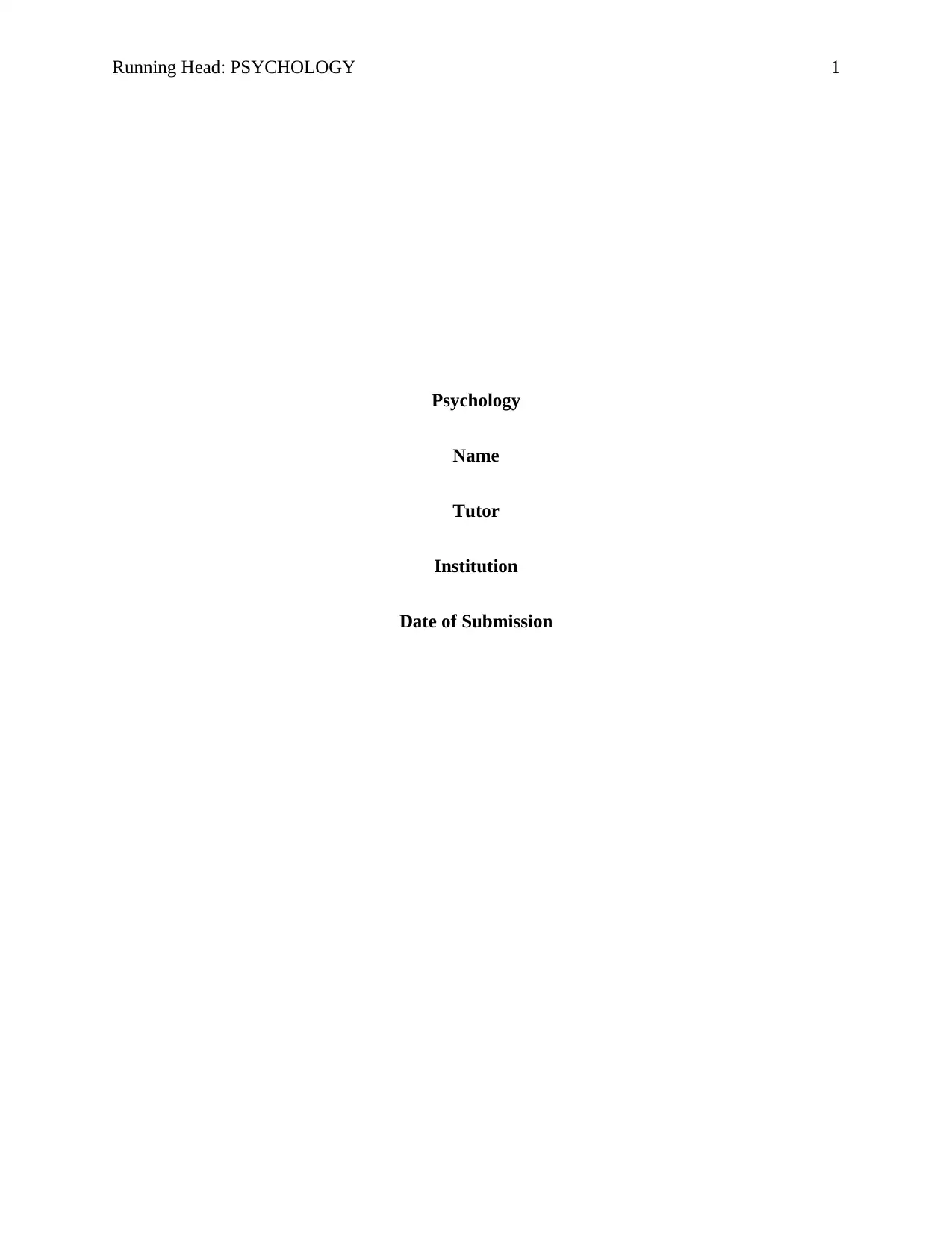
Running Head: PSYCHOLOGY 1
Psychology
Name
Tutor
Institution
Date of Submission
Psychology
Name
Tutor
Institution
Date of Submission
Paraphrase This Document
Need a fresh take? Get an instant paraphrase of this document with our AI Paraphraser
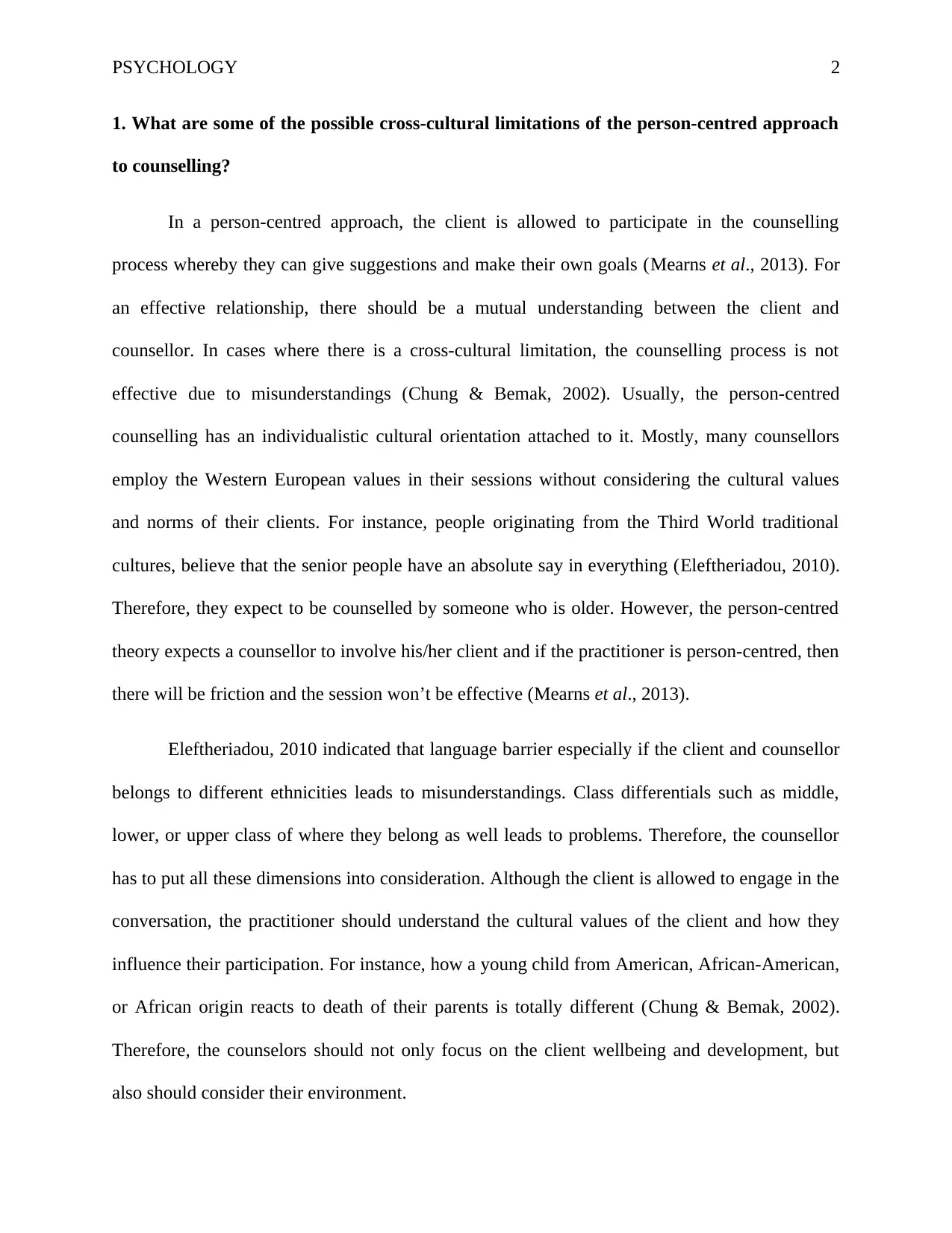
PSYCHOLOGY 2
1. What are some of the possible cross-cultural limitations of the person-centred approach
to counselling?
In a person-centred approach, the client is allowed to participate in the counselling
process whereby they can give suggestions and make their own goals (Mearns et al., 2013). For
an effective relationship, there should be a mutual understanding between the client and
counsellor. In cases where there is a cross-cultural limitation, the counselling process is not
effective due to misunderstandings (Chung & Bemak, 2002). Usually, the person-centred
counselling has an individualistic cultural orientation attached to it. Mostly, many counsellors
employ the Western European values in their sessions without considering the cultural values
and norms of their clients. For instance, people originating from the Third World traditional
cultures, believe that the senior people have an absolute say in everything (Eleftheriadou, 2010).
Therefore, they expect to be counselled by someone who is older. However, the person-centred
theory expects a counsellor to involve his/her client and if the practitioner is person-centred, then
there will be friction and the session won’t be effective (Mearns et al., 2013).
Eleftheriadou, 2010 indicated that language barrier especially if the client and counsellor
belongs to different ethnicities leads to misunderstandings. Class differentials such as middle,
lower, or upper class of where they belong as well leads to problems. Therefore, the counsellor
has to put all these dimensions into consideration. Although the client is allowed to engage in the
conversation, the practitioner should understand the cultural values of the client and how they
influence their participation. For instance, how a young child from American, African-American,
or African origin reacts to death of their parents is totally different (Chung & Bemak, 2002).
Therefore, the counselors should not only focus on the client wellbeing and development, but
also should consider their environment.
1. What are some of the possible cross-cultural limitations of the person-centred approach
to counselling?
In a person-centred approach, the client is allowed to participate in the counselling
process whereby they can give suggestions and make their own goals (Mearns et al., 2013). For
an effective relationship, there should be a mutual understanding between the client and
counsellor. In cases where there is a cross-cultural limitation, the counselling process is not
effective due to misunderstandings (Chung & Bemak, 2002). Usually, the person-centred
counselling has an individualistic cultural orientation attached to it. Mostly, many counsellors
employ the Western European values in their sessions without considering the cultural values
and norms of their clients. For instance, people originating from the Third World traditional
cultures, believe that the senior people have an absolute say in everything (Eleftheriadou, 2010).
Therefore, they expect to be counselled by someone who is older. However, the person-centred
theory expects a counsellor to involve his/her client and if the practitioner is person-centred, then
there will be friction and the session won’t be effective (Mearns et al., 2013).
Eleftheriadou, 2010 indicated that language barrier especially if the client and counsellor
belongs to different ethnicities leads to misunderstandings. Class differentials such as middle,
lower, or upper class of where they belong as well leads to problems. Therefore, the counsellor
has to put all these dimensions into consideration. Although the client is allowed to engage in the
conversation, the practitioner should understand the cultural values of the client and how they
influence their participation. For instance, how a young child from American, African-American,
or African origin reacts to death of their parents is totally different (Chung & Bemak, 2002).
Therefore, the counselors should not only focus on the client wellbeing and development, but
also should consider their environment.
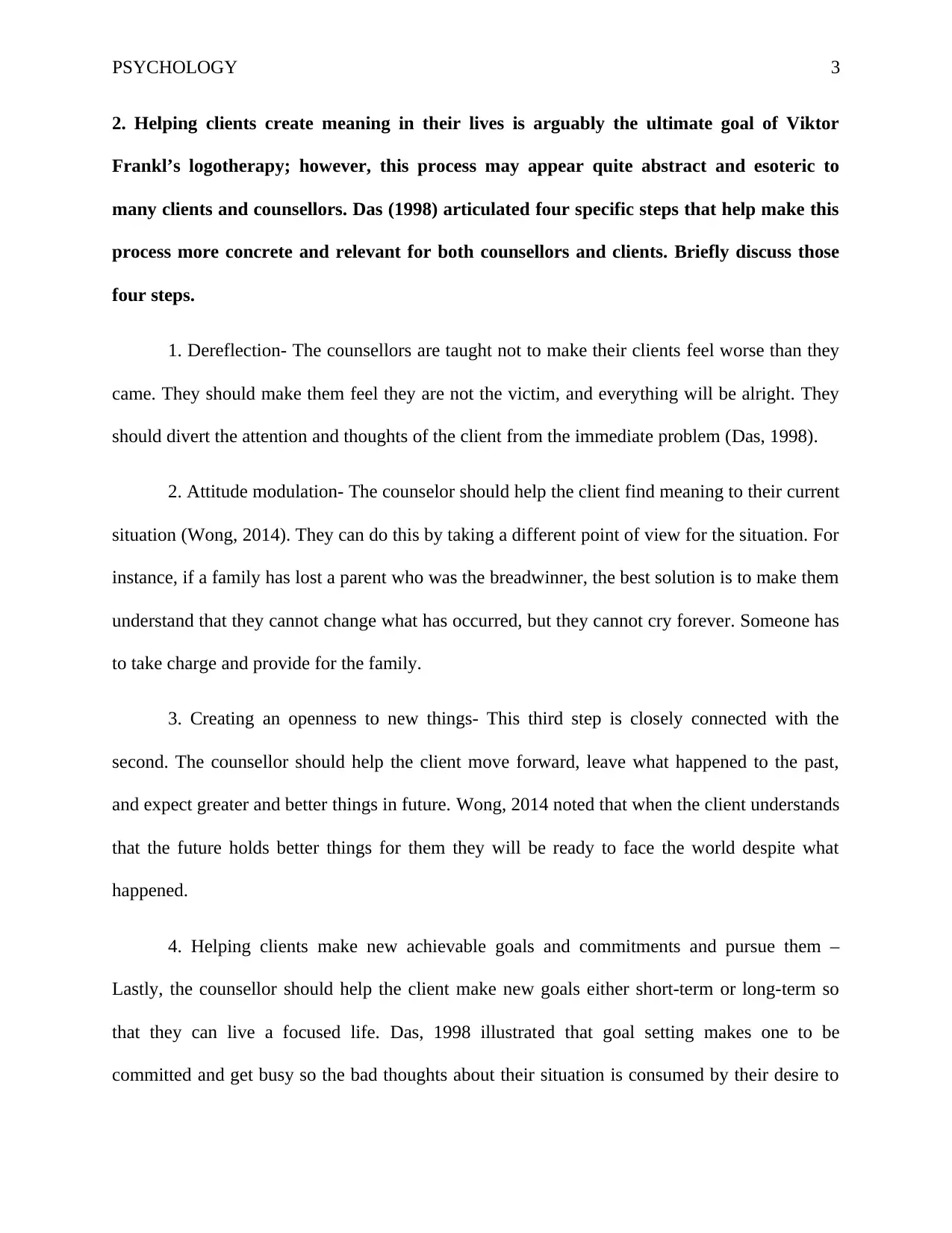
PSYCHOLOGY 3
2. Helping clients create meaning in their lives is arguably the ultimate goal of Viktor
Frankl’s logotherapy; however, this process may appear quite abstract and esoteric to
many clients and counsellors. Das (1998) articulated four specific steps that help make this
process more concrete and relevant for both counsellors and clients. Briefly discuss those
four steps.
1. Dereflection- The counsellors are taught not to make their clients feel worse than they
came. They should make them feel they are not the victim, and everything will be alright. They
should divert the attention and thoughts of the client from the immediate problem (Das, 1998).
2. Attitude modulation- The counselor should help the client find meaning to their current
situation (Wong, 2014). They can do this by taking a different point of view for the situation. For
instance, if a family has lost a parent who was the breadwinner, the best solution is to make them
understand that they cannot change what has occurred, but they cannot cry forever. Someone has
to take charge and provide for the family.
3. Creating an openness to new things- This third step is closely connected with the
second. The counsellor should help the client move forward, leave what happened to the past,
and expect greater and better things in future. Wong, 2014 noted that when the client understands
that the future holds better things for them they will be ready to face the world despite what
happened.
4. Helping clients make new achievable goals and commitments and pursue them –
Lastly, the counsellor should help the client make new goals either short-term or long-term so
that they can live a focused life. Das, 1998 illustrated that goal setting makes one to be
committed and get busy so the bad thoughts about their situation is consumed by their desire to
2. Helping clients create meaning in their lives is arguably the ultimate goal of Viktor
Frankl’s logotherapy; however, this process may appear quite abstract and esoteric to
many clients and counsellors. Das (1998) articulated four specific steps that help make this
process more concrete and relevant for both counsellors and clients. Briefly discuss those
four steps.
1. Dereflection- The counsellors are taught not to make their clients feel worse than they
came. They should make them feel they are not the victim, and everything will be alright. They
should divert the attention and thoughts of the client from the immediate problem (Das, 1998).
2. Attitude modulation- The counselor should help the client find meaning to their current
situation (Wong, 2014). They can do this by taking a different point of view for the situation. For
instance, if a family has lost a parent who was the breadwinner, the best solution is to make them
understand that they cannot change what has occurred, but they cannot cry forever. Someone has
to take charge and provide for the family.
3. Creating an openness to new things- This third step is closely connected with the
second. The counsellor should help the client move forward, leave what happened to the past,
and expect greater and better things in future. Wong, 2014 noted that when the client understands
that the future holds better things for them they will be ready to face the world despite what
happened.
4. Helping clients make new achievable goals and commitments and pursue them –
Lastly, the counsellor should help the client make new goals either short-term or long-term so
that they can live a focused life. Das, 1998 illustrated that goal setting makes one to be
committed and get busy so the bad thoughts about their situation is consumed by their desire to
⊘ This is a preview!⊘
Do you want full access?
Subscribe today to unlock all pages.

Trusted by 1+ million students worldwide
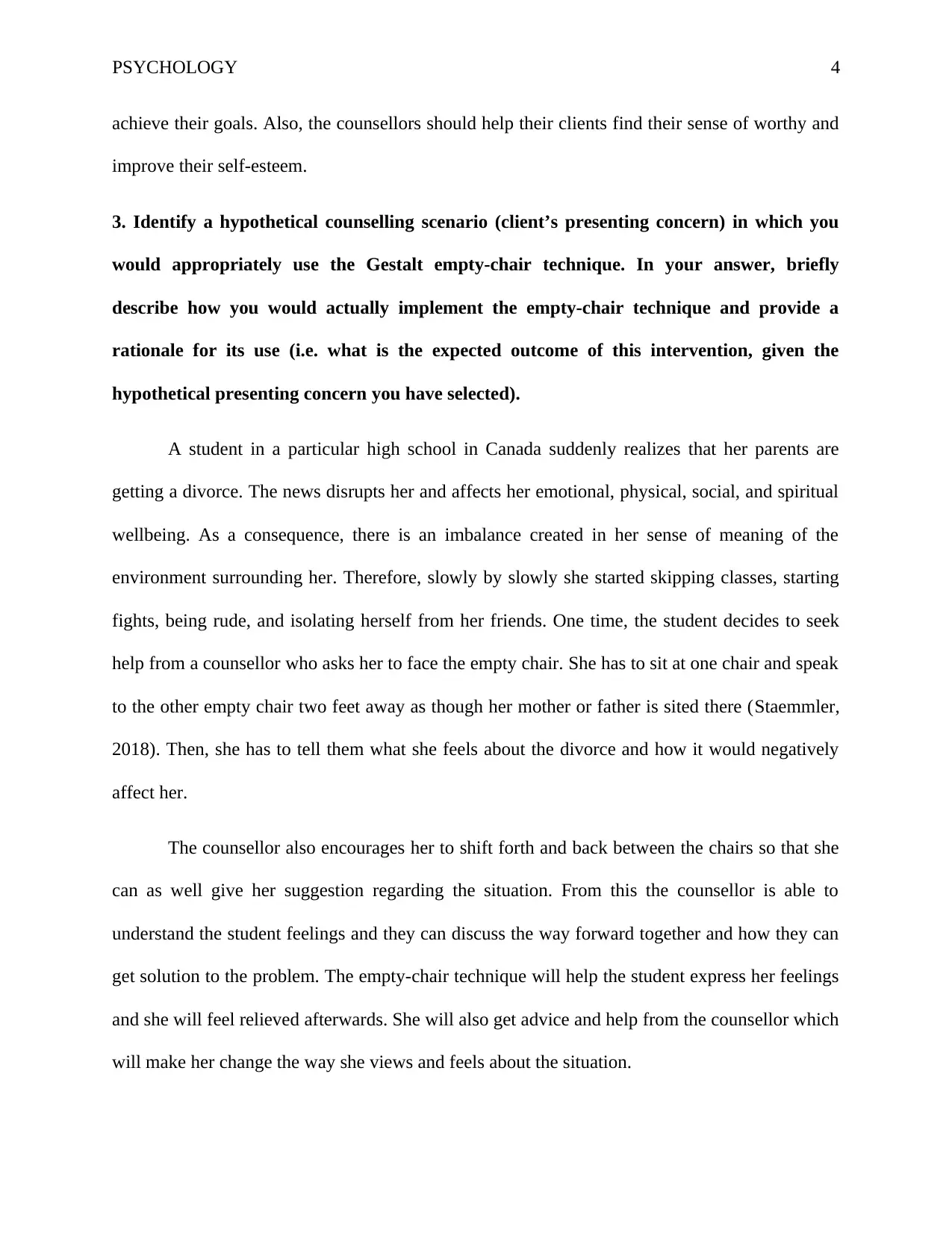
PSYCHOLOGY 4
achieve their goals. Also, the counsellors should help their clients find their sense of worthy and
improve their self-esteem.
3. Identify a hypothetical counselling scenario (client’s presenting concern) in which you
would appropriately use the Gestalt empty-chair technique. In your answer, briefly
describe how you would actually implement the empty-chair technique and provide a
rationale for its use (i.e. what is the expected outcome of this intervention, given the
hypothetical presenting concern you have selected).
A student in a particular high school in Canada suddenly realizes that her parents are
getting a divorce. The news disrupts her and affects her emotional, physical, social, and spiritual
wellbeing. As a consequence, there is an imbalance created in her sense of meaning of the
environment surrounding her. Therefore, slowly by slowly she started skipping classes, starting
fights, being rude, and isolating herself from her friends. One time, the student decides to seek
help from a counsellor who asks her to face the empty chair. She has to sit at one chair and speak
to the other empty chair two feet away as though her mother or father is sited there (Staemmler,
2018). Then, she has to tell them what she feels about the divorce and how it would negatively
affect her.
The counsellor also encourages her to shift forth and back between the chairs so that she
can as well give her suggestion regarding the situation. From this the counsellor is able to
understand the student feelings and they can discuss the way forward together and how they can
get solution to the problem. The empty-chair technique will help the student express her feelings
and she will feel relieved afterwards. She will also get advice and help from the counsellor which
will make her change the way she views and feels about the situation.
achieve their goals. Also, the counsellors should help their clients find their sense of worthy and
improve their self-esteem.
3. Identify a hypothetical counselling scenario (client’s presenting concern) in which you
would appropriately use the Gestalt empty-chair technique. In your answer, briefly
describe how you would actually implement the empty-chair technique and provide a
rationale for its use (i.e. what is the expected outcome of this intervention, given the
hypothetical presenting concern you have selected).
A student in a particular high school in Canada suddenly realizes that her parents are
getting a divorce. The news disrupts her and affects her emotional, physical, social, and spiritual
wellbeing. As a consequence, there is an imbalance created in her sense of meaning of the
environment surrounding her. Therefore, slowly by slowly she started skipping classes, starting
fights, being rude, and isolating herself from her friends. One time, the student decides to seek
help from a counsellor who asks her to face the empty chair. She has to sit at one chair and speak
to the other empty chair two feet away as though her mother or father is sited there (Staemmler,
2018). Then, she has to tell them what she feels about the divorce and how it would negatively
affect her.
The counsellor also encourages her to shift forth and back between the chairs so that she
can as well give her suggestion regarding the situation. From this the counsellor is able to
understand the student feelings and they can discuss the way forward together and how they can
get solution to the problem. The empty-chair technique will help the student express her feelings
and she will feel relieved afterwards. She will also get advice and help from the counsellor which
will make her change the way she views and feels about the situation.
Paraphrase This Document
Need a fresh take? Get an instant paraphrase of this document with our AI Paraphraser
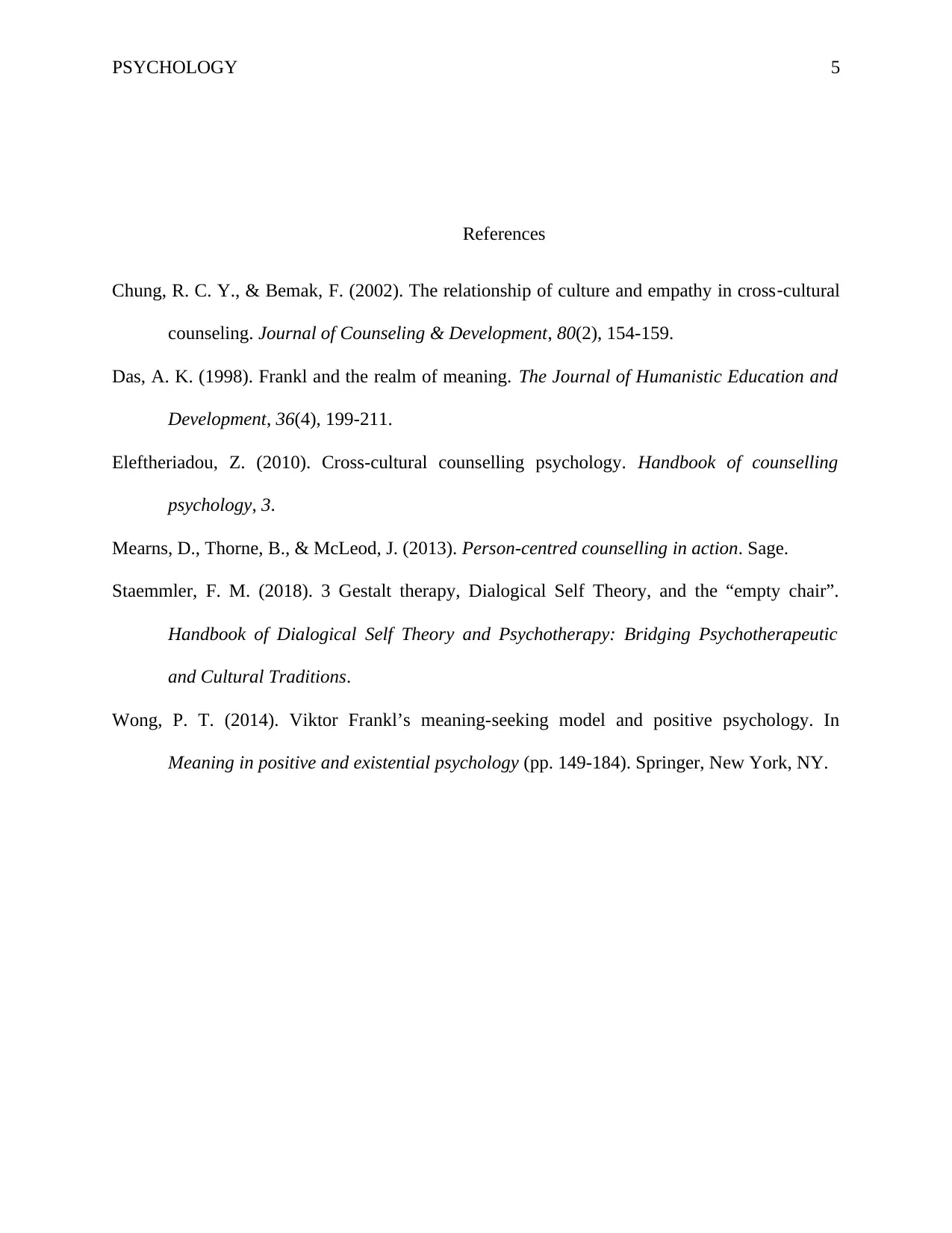
PSYCHOLOGY 5
References
Chung, R. C. Y., & Bemak, F. (2002). The relationship of culture and empathy in cross‐cultural
counseling. Journal of Counseling & Development, 80(2), 154-159.
Das, A. K. (1998). Frankl and the realm of meaning. The Journal of Humanistic Education and
Development, 36(4), 199-211.
Eleftheriadou, Z. (2010). Cross-cultural counselling psychology. Handbook of counselling
psychology, 3.
Mearns, D., Thorne, B., & McLeod, J. (2013). Person-centred counselling in action. Sage.
Staemmler, F. M. (2018). 3 Gestalt therapy, Dialogical Self Theory, and the “empty chair”.
Handbook of Dialogical Self Theory and Psychotherapy: Bridging Psychotherapeutic
and Cultural Traditions.
Wong, P. T. (2014). Viktor Frankl’s meaning-seeking model and positive psychology. In
Meaning in positive and existential psychology (pp. 149-184). Springer, New York, NY.
References
Chung, R. C. Y., & Bemak, F. (2002). The relationship of culture and empathy in cross‐cultural
counseling. Journal of Counseling & Development, 80(2), 154-159.
Das, A. K. (1998). Frankl and the realm of meaning. The Journal of Humanistic Education and
Development, 36(4), 199-211.
Eleftheriadou, Z. (2010). Cross-cultural counselling psychology. Handbook of counselling
psychology, 3.
Mearns, D., Thorne, B., & McLeod, J. (2013). Person-centred counselling in action. Sage.
Staemmler, F. M. (2018). 3 Gestalt therapy, Dialogical Self Theory, and the “empty chair”.
Handbook of Dialogical Self Theory and Psychotherapy: Bridging Psychotherapeutic
and Cultural Traditions.
Wong, P. T. (2014). Viktor Frankl’s meaning-seeking model and positive psychology. In
Meaning in positive and existential psychology (pp. 149-184). Springer, New York, NY.
1 out of 5
Your All-in-One AI-Powered Toolkit for Academic Success.
+13062052269
info@desklib.com
Available 24*7 on WhatsApp / Email
![[object Object]](/_next/static/media/star-bottom.7253800d.svg)
Unlock your academic potential
Copyright © 2020–2025 A2Z Services. All Rights Reserved. Developed and managed by ZUCOL.